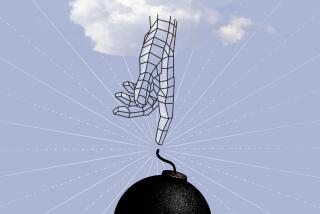MOSIS Points to Technology’s Promised Land
- Share via
There’s an office across from a yacht basin in Marina del Rey that would please a lot of efficiency experts. The place is super clean. No desk tops littered with yesterday’s shopping lists, unreturned phone messages or snapshots of the family. Instead of the babble of voices, there’s just a gentle hum.
It’s ideal--if you don’t mind the fact that there aren’t any people. It’s a room full of computers, and except for a few managers in separate offices, they are the entire work force of an outfit called MOSIS. Those machines communicate with customers, accept their orders, sort them into production batches and send them off to be produced. No sales and marketing people. Just machines. You get the feeling they were made to hum just to reassure mere humans that something is going on.
And indeed, something is. This $4-million-a-year operation with the biblical sounding name (actually, it stands for a not-so-biblical-sounding Metal Oxide Semiconductor Implementation System) is an indication of how radically computers can change things, of why the computer revolution is only beginning.
MOSIS is a nonprofit, government-funded business under the wing of the USC Information Sciences Institute. It is the result of what visitors are assured was a rather simple invention, a means by which computers can be programmed to run a manufacturing operation so that instead of mass producing an identical item it’s possible to turn out an infinite variety. But that’s getting a little ahead of the story.
Integrated circuits of various designs are the brains of computers and electronic equipment. Designing new circuitry is a key part of research work that leads to product innovation and improvement. Scores of these designs are etched into a single silicon wafer about the size of a large chocolate chip cookie. (Originally they were made by a metal oxide process, explaining where MOSIS got its name.) The wafers are expensive to produce, and the only hope for profit is to make them in large quantity.
This is fine for some users, and major companies with lots of resources can afford the cost. But suppose all you want to do is test some new circuit designs? Producing a test quantity can be outrageously expensive, and getting on somebody’s production schedule can take many months.
Along comes MOSIS, a computer system that takes individual requests for new circuit designs, puts them together with other requests and produces a tape that manufacturers of those cookie-size wafers can use to run their computerized production operations. The manufacturers still have cost-efficient mass production, but the customers can order just a small quantity of each individual test circuit. Suddenly what might have cost $40,000 or more can be done for $2,000 a test, and the order lead time is reduced to a manageable eight weeks. Result: More testing and more potential innovation.
MOSIS was launched in 1980 with funds from the Defense Advanced Research Projects Agency, not one of your better-known government entities but one that fosters a lot of work at the frontiers of technology.
In addition to military and aerospace applications, 60 major universities use MOSIS in engineering research work. The plan now is to broaden the base of universities to 1,000, permitting undergraduate as well as graduate engineers the chance to play with new circuit designs. Expanded use of MOSIS by private industry is expected to come next.
All of this has implications for the nation’s economy. Many experts believe that to maintain its manufacturing might against low-cost, mass producers in other parts of the world, the United States must step up the pace of innovation and develop inexpensive means to produce top-quality, custom-made products. With systems like MOSIS, production lines could churn out masses of, say, cars but with infinite variations.
What MOSIS also does is permit small firms, previously unable to compete with the giants and their huge research and development budgets, to pursue R&D; at relatively low cost.
Not bad for a room without people. It’s just an awful waste locating a bunch of machines across from a yacht basin.
More to Read
Inside the business of entertainment
The Wide Shot brings you news, analysis and insights on everything from streaming wars to production — and what it all means for the future.
You may occasionally receive promotional content from the Los Angeles Times.










